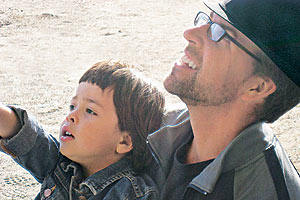Food is more than just a way to stay alive. It’s also a force that ties the human community together, through universal need, border-crossing commerce, kitchen gossip and dinner table conversation, potlucks and picnics, restaurants and cafes, all the places and times when we come together as friends, families, communities.
Human relationships—and our relationships with our food—have always been shaped by technology. And today, the Internet and mobile technologies are revolutionizing our communities and food consumption to degrees we are only just starting to understand. Technology has created many problems in the way food is grown, distributed, and consumed. But could technology offer solutions as well?
To help answer that question, Shareable.net teamed up with the research consultancy Latitude to study how digital connectivity shapes food choices. On Tuesday, we described how mobile technologies are now helping people interface with food; on Wednesday, we revealed participant ideas for how connectivity might help us make better food choices.
Today, we explore what our study suggests about new opportunities for local sharing and community building. “No matter what information we're after, community (and therefore trust!) seems to be an important part of it,” wrote study leader Marina Miloslavsky in a comment on Tuesday’s installment of this series. She continued:
“Personally, I buy my fruits and vegetables at a local farmer's market, and I trust what my grocer is telling me about that produce. And I trust him to tell me when he doesn't know certain information, too. Examining all of our entries for this study, people certainly mentioned shopping at farmer's markets, co-ops, and other places where building that community is easier than at a traditional supermarket.”
Thus our participants simultaneously recognized the limits as well as the promises of technology. An iPhone app might help us to navigate a world of consumer choices in a way that's more environmentally and nutritionally responsible, but we're also seeking real community. The closer the information source, the more it is trusted. For example, only 14 percent of participants mentioned that they’d like to receive background/product information from suppliers, but 51 percent said they’d like to receive this type of information from stores where they shop (response options were not mutually exclusive).
In addition to real contact with stores and co-ops that seem to share and reflect the values of shoppers, and provide a sense of neighborliness, some participants suggested that “objective” information is increasingly established through aggregating many, often diverse, perspectives. That’s where technology can prove helpful. As one participant put it:
“Blogs, blogs, blogs. Ranking systems, rating systems, investigative journalism, I get it all through the Internet. I have apps for my iPhone like 'don't eat that' and 'good guide' that help me at the store too. I learn as much as I can at home, and then carry reference systems in the form of seafood guides and price checkers for my phone.” – Participant submission, "The Interactive Future of Food"
Another participant emphasized that the information should best come through diverse sources, and that each point of access should touch the others and form a kind of dialog:
“Some sort of a kiosk with internet access, store-provided information, and a local shopper's community would have been possibly quite helpful. As what I needed were product reviews for subjective qualities, it would have been important for me to know that people were free to speak their minds (within the limits of respectful language), so the equivalent of moderated message boards with a commitment to free expression could have worked. Also, some sort of prompting for customers who left reviews to describe their experience as a user, not just rave or complain, would help; as would some rateable items, such as 'flavor' and 'mixing', depending on the items in question. This could also be nice if it could be accessed from home, and perhaps encouraged participation with coupons or special deals of some sort.” – Participant submission, "The Interactive Future of Food"
These perspectives suggest that stores—both chains and independents—can improve shopping experiences by helping to aggregate information and provide more nutritional and environmental information for customers.
These combined notions lead to a superficially paradoxical conception of the grocery store as both a node in a wider network and a focal point for local community, where members can congregate, share information, and aggregate their information with other communities. “The store of the next generation will look like a combination of the local farmer's market and the food cooperative owned locally by the community,” wrote one study participant, who continued:
“It will not only be a place to buy food, but a place to connect with your local community in real ways. There'll be some layers for Internet information sharing, many of these are already in place. Food co-op and many farmer's markets utilize the internet to keep customers and members up to date and even giving them the opportunity to pre-order a farmer's market delivery…giving the farmer more specific information for how much needs to be picked (less waste). In the end, local food and sustainability will be best served by appropriate use of technology and information, not information and technology overload (people may already be experiencing that with digitized self-checkout scanning carts and neon lights all a glow).” – Participant submission, "The Interactive Future of Food"









